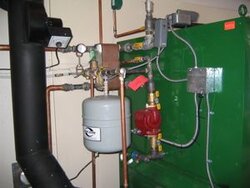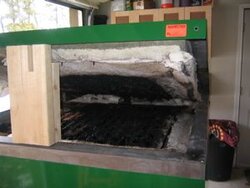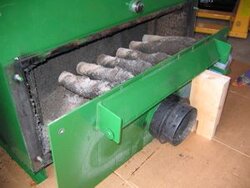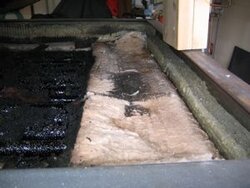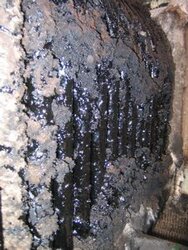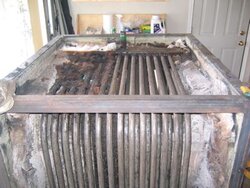I started the spring cleaning of the Greenwood today. Dismantled, moved and opened her up. For those Greenwood owners that are interested, I will post some pictures and give a short description once I finish the cleaning.
Cleaning the Greenwood w/pics.
- Thread starter DKerley
- Start date
-
Active since 1995, Hearth.com is THE place on the internet for free information and advice about wood stoves, pellet stoves and other energy saving equipment.
We strive to provide opinions, articles, discussions and history related to Hearth Products and in a more general sense, energy issues.
We promote the EFFICIENT, RESPONSIBLE, CLEAN and SAFE use of all fuels, whether renewable or fossil.
You are using an out of date browser. It may not display this or other websites correctly.
You should upgrade or use an alternative browser.
You should upgrade or use an alternative browser.
- Status
- Not open for further replies.
tigermaple
Member
Doug,
I take it the temp has got back above 0ºF in your part of the woods. I look forward to the picts and story.
Good Luck
I take it the temp has got back above 0ºF in your part of the woods. I look forward to the picts and story.
Good Luck
antos_ketcham
Member
- Mar 5, 2008
- 155
Doug -
Can you please include a play by play of exactly how one dismantles the GW? Looking at mine, there are many soldered pipes and other plumbing components that would keep me from taking off the back of the boiler to clean the back pipes. Please advise.
Pete
Can you please include a play by play of exactly how one dismantles the GW? Looking at mine, there are many soldered pipes and other plumbing components that would keep me from taking off the back of the boiler to clean the back pipes. Please advise.
Pete
Hi Pete,
Looking at your installation photo in another thread, it looks as if your unit is not easily moveable. I was able to disconnect the plumbing and chimney at the back of my unit and then lift the GW with a pallet jack moving it forward and out of the way. I did have to cut one of my small copper pipes leading to a dump zone that did not have a union, otherwise, I disconnected the plumbing at the union leading to the flat plate HX and at the base of the Greenwood circulation pump. Most of the electrics had to come off as well. When I put it back together, I will see if I can install unions on the GW on the main heat exchanger. Once I finish up the cleaning, I will write up a detailed description of how I did mine with pics.
Looking at your installation photo in another thread, it looks as if your unit is not easily moveable. I was able to disconnect the plumbing and chimney at the back of my unit and then lift the GW with a pallet jack moving it forward and out of the way. I did have to cut one of my small copper pipes leading to a dump zone that did not have a union, otherwise, I disconnected the plumbing at the union leading to the flat plate HX and at the base of the Greenwood circulation pump. Most of the electrics had to come off as well. When I put it back together, I will see if I can install unions on the GW on the main heat exchanger. Once I finish up the cleaning, I will write up a detailed description of how I did mine with pics.
How did you make out? I started to notice loss of efficiency after 3 months of use. I took the top and side off today. I found a tremendous amount of fly ash and the skin has a bit of rust on it. I am going to call the manufacturer tomorrow. There is no way you can run these units with out access to the Hx. IMO the hex should be cleaned every month or so. I don't want to make an access because to me that must void warranty. I will let you know if the manufacturer takes care of it...
Here is a quick step by step of the procedure that in used to clean the heat exchanger on my Greenwood 200. Please note that the accumulation of fly ash and creosote only happened on the heat exchanger. This is believed to be the result of low water return temperatures to the exchanger. I am having my system modified to prevent the cool water from entering the exchanger, thus hopefully, preventing the same next season. In addition to the previously mentioned modification, I am adding two unions at the connections to the heat exchanger so that I can quick disconnect the plumbing if required to access the back of the unit for future cleaning.
Step 1. Disconnect all of the plumbing to be able to remove both the top panel and rear panel on the unit. I disconnected at the circulation pump and at the heat exchanger as both had unions for easy removal. I then used a pallet jack to move the unit into a clear area.

Step 2. Remove all screws and eye bolts and lift off top. Note - The top may be difficult to lift if the insulation has stuck to the heat exchanger tubes as a result of creosote and/or condensation. Go slowly and try not to damage the insulation.

Step 3. Remove bottom panel on rear of unit. Pull straight back off the bolts and the air intake tubes will be free of the refractory.

Step 4. Remove upper rear panel. Note - there is a 12" deep piece of insulation that lays on the bend of the heat exchanger that is attached to the top of the rear panel. Be careful to free the insulation from the heat exchanger tubes if sticking prior to removal of the rear panel to prevent damaging the insulation.

Step 5. Start scraping off the heat exchanger tubes with, ideally, the cleaning tool being produced by greenwood. It works well in combination with a stiiff narrow paint scraper. Plan on a few hours of scraping depending on how bad your unit is. Mine took about 5 hours of scraping.

Step 6. Put it all back together and modify your system so that the heat exchanger is protected from cold water return. Be sure to put back the insulation exactly as it was when you took it apart. Pictures help.
I am hoping that the pics went in the correct position after each step. This is my first time attempting the embedding of pictures.
Step 1. Disconnect all of the plumbing to be able to remove both the top panel and rear panel on the unit. I disconnected at the circulation pump and at the heat exchanger as both had unions for easy removal. I then used a pallet jack to move the unit into a clear area.

Step 2. Remove all screws and eye bolts and lift off top. Note - The top may be difficult to lift if the insulation has stuck to the heat exchanger tubes as a result of creosote and/or condensation. Go slowly and try not to damage the insulation.

Step 3. Remove bottom panel on rear of unit. Pull straight back off the bolts and the air intake tubes will be free of the refractory.

Step 4. Remove upper rear panel. Note - there is a 12" deep piece of insulation that lays on the bend of the heat exchanger that is attached to the top of the rear panel. Be careful to free the insulation from the heat exchanger tubes if sticking prior to removal of the rear panel to prevent damaging the insulation.

Step 5. Start scraping off the heat exchanger tubes with, ideally, the cleaning tool being produced by greenwood. It works well in combination with a stiiff narrow paint scraper. Plan on a few hours of scraping depending on how bad your unit is. Mine took about 5 hours of scraping.

Step 6. Put it all back together and modify your system so that the heat exchanger is protected from cold water return. Be sure to put back the insulation exactly as it was when you took it apart. Pictures help.
I am hoping that the pics went in the correct position after each step. This is my first time attempting the embedding of pictures.
Attachments
Hi Sparke,
I just posted a brief description on a new thread called "Cleaning the Greenwood w/pics.
I just posted a brief description on a new thread called "Cleaning the Greenwood w/pics.
Doug, I merged the threads.
How dry was the fuel burned this season? Is this a typical year's accumulation?
How dry was the fuel burned this season? Is this a typical year's accumulation?
Hi Be Green,
The majority of the wood was around 11%. Some went as high as about 18%. It was all beetle killed spruce and or pine. This was my first year operating the boiler and i am hoping for a much cleaner burn next year as I feel that I have climbed a fair distance up the steep learning curve. I forgot to post a close to being finished cleaning pic.
The majority of the wood was around 11%. Some went as high as about 18%. It was all beetle killed spruce and or pine. This was my first year operating the boiler and i am hoping for a much cleaner burn next year as I feel that I have climbed a fair distance up the steep learning curve. I forgot to post a close to being finished cleaning pic.
Attachments
Hi Steve,
I don't have a temperature gauge on the return water pipe from the external heat exchanger going into the boiler, but I have been told by Greenwood, that this return water must not be less than 130 - 135 deg F., otherwise ,the heat exchanger will collect creosote. The worst build up is at the base of the Greenwood heat exchanger where the return water enters. The boiler output temperature does not really tell you what your return temp is as there are many variables. If you let your fire go out and have to restart, you are pretty well assured that your return water temp is too low. How clean is your heat exchanger?
I don't have a temperature gauge on the return water pipe from the external heat exchanger going into the boiler, but I have been told by Greenwood, that this return water must not be less than 130 - 135 deg F., otherwise ,the heat exchanger will collect creosote. The worst build up is at the base of the Greenwood heat exchanger where the return water enters. The boiler output temperature does not really tell you what your return temp is as there are many variables. If you let your fire go out and have to restart, you are pretty well assured that your return water temp is too low. How clean is your heat exchanger?
Doug, I will have a better idea about clean after I feel comfortable with outdoor temps, but from taking off the stove pipe and peering up inside with a mirror, I think I am pretty clean. The picture of the rear of your hx is a eye opener though. With 300 gallons of storage I didn't see return temps less than 140 most of the winter. Hope to up size to 800 gallons over the summer.
Steve
Steve
roaring fire
New Member
Doug thanks for shedding light on the the back of those water vessels
If low water temps are causing all this creceote we are killing those boilers
during the shoulder season by doing a cold start up each day. I thought
the main culprit was burning green wood but your report of 11 to 18%
is good dry wood in my book. Fred Seton said he has sold this design for 20
years & I am hauntingly reminded of a remark by the Webmaster ... in all the time
he sold Tarm he had not heard of Seton. This design ,which is at the heart of the beast,
is not going to cut it, if the manufacturer can't come up with a user friendly way
of cleaning those vessels.
The annual regular maintenance recommended by Greenwood , Seton make
no mention of cleaning the vessel, out of sight out of mind I guess.
If low water temps are causing all this creceote we are killing those boilers
during the shoulder season by doing a cold start up each day. I thought
the main culprit was burning green wood but your report of 11 to 18%
is good dry wood in my book. Fred Seton said he has sold this design for 20
years & I am hauntingly reminded of a remark by the Webmaster ... in all the time
he sold Tarm he had not heard of Seton. This design ,which is at the heart of the beast,
is not going to cut it, if the manufacturer can't come up with a user friendly way
of cleaning those vessels.
The annual regular maintenance recommended by Greenwood , Seton make
no mention of cleaning the vessel, out of sight out of mind I guess.
sparke said:Nice documentation Dkerley. What did you do for return protection? Termovar?
Hi Sparke,
I have been told by Greenwood and by the plumber that did my installation, that there are several different options for return protection. I still have my unit's plumbing apart waiting for the plumber. I believe that he is proposing installing a couple of "T's" in both the supply and return from the external HX coupled with a pump and a temperature gauge and a few other parts. Greenwood is putting together a modification kit that should be ready very soon through their parts department.
stihlwoody said:Doug, I will have a better idea about clean after I feel comfortable with outdoor temps, but from taking off the stove pipe and peering up inside with a mirror, I think I am pretty clean. The picture of the rear of your hx is a eye opener though. With 300 gallons of storage I didn't see return temps less than 140 most of the winter. Hope to up size to 800 gallons over the summer.
Steve
Hi Steve,
I am glad that you may have burned clean. If I am not mistaken, I think that you are burning primarily birch. I was burning very high pitch wood both beetle killed spruce and pine. Not sure if that makes mine more susceptible or not. I too am looking at water storage as a potential option for the shoulder seasons but only because I would also like to add a couple of solar panels for the DHW during the summer.
roaring fire said:Doug thanks for shedding light on the the back of those water vessels
If low water temps are causing all this creceote we are killing those boilers
during the shoulder season by doing a cold start up each day. I thought
the main culprit was burning green wood but your report of 11 to 18%
is good dry wood in my book. Fred Seton said he has sold this design for 20
years & I am hauntingly reminded of a remark by the Webmaster ... in all the time
he sold Tarm he had not heard of Seton. This design ,which is at the heart of the beast,
is not going to cut it, if the manufacturer can't come up with a user friendly way
of cleaning those vessels.
The annual regular maintenance recommended by Greenwood , Seton make
no mention of cleaning the vessel, out of sight out of mind I guess.
Hello Roaring Fire,
Greenwood has issued a technical bulletin regarding cleaning of the heat exchanger. There are definitely plans to attempt to prevent the accumulation of creosote plus some form of improved access. I have no affiliation with Greenwood whatsoever, found out about them by surfing the internet after the insurance companies would insure an OWB on my property (too many trees). I believe that this is a good product that needs a little tweaking to make it a great product. Where I live, I am having to deal with temps as low as -50 in January to above freezing in the shoulder months. Even my high efficiency propane forced air furnace wasn't optimized for the extremes.
roaring fire
New Member
For all of us using this design I hope you are right. The owners , maintenance manual
definitely made no mention of cleaning the vessel. I guess they issued the bulletin
following complaints of plugged vessels. So you pay a big chunk of change ie 10 or 12 grand
to the company & they end up using you as a LAB RAT!
Being an early adopter you would think Greenwood would give you a break on the price tag
no luck there You have to pay through the nose with those guys.
Anyway Doug I hope all your extra hard work & $$$ pays off.
definitely made no mention of cleaning the vessel. I guess they issued the bulletin
following complaints of plugged vessels. So you pay a big chunk of change ie 10 or 12 grand
to the company & they end up using you as a LAB RAT!
Being an early adopter you would think Greenwood would give you a break on the price tag
no luck there You have to pay through the nose with those guys.
Anyway Doug I hope all your extra hard work & $$$ pays off.
Dkerley, I just finished my cleaning as well. I did a few things to make this easy in the future.
1. I re-plumbed the boiler piping with unions so I can take the top of very easy. ( I should not have to take the top off often).
2. For cold water protection. I could not find a termovar or similar mixing valve. For now I put in a tee from supply to return with a ball valve. I will crack it open just enough to recycle some hot water through the Hx. Not sure if it will work but it is better then nothing.
3. Instead of siliconing the top and side - I siliconed a strip of 1/4" gasket around the top and side frames. This way I can take of the side panel off in about 3 minutes without the silicone problem...
1. I re-plumbed the boiler piping with unions so I can take the top of very easy. ( I should not have to take the top off often).
2. For cold water protection. I could not find a termovar or similar mixing valve. For now I put in a tee from supply to return with a ball valve. I will crack it open just enough to recycle some hot water through the Hx. Not sure if it will work but it is better then nothing.
3. Instead of siliconing the top and side - I siliconed a strip of 1/4" gasket around the top and side frames. This way I can take of the side panel off in about 3 minutes without the silicone problem...
heaterman
Minister of Fire
That my good man is a mess. If your wood is running the moisture content that you indicated, I'd strongly suspect that you need to elevate your return temps somehow. With pine, fir, spruce etc. you have to run a hot fire and I'd suggest keeping your return temp in the 140-150 range via a mix valve or injection mixing setup. What type of heating system are you driving with this boiler?
I would make sure that your plumber understands that the mixing device is for the protection of the boiler by keeping return temps elevated. If you are driving a radiant floor slab or other low temp emitter, you will then need to include something to knock that supply temp down.
Kind of a catch22 situation. The boiler needs to be hot but the floor needs a lower temp than the boiler will tolerate. Ain't it fun though?
I would make sure that your plumber understands that the mixing device is for the protection of the boiler by keeping return temps elevated. If you are driving a radiant floor slab or other low temp emitter, you will then need to include something to knock that supply temp down.
Kind of a catch22 situation. The boiler needs to be hot but the floor needs a lower temp than the boiler will tolerate. Ain't it fun though?
roaring fire
New Member
Hi Heaterman
To bad Greenwood & the others wouldn't hire a consultant like yourself before they dump those monsters on the market.
I believe you could save a lot of grief for potential buyers.In this year of Our Lord 2008 is there anything available
that will get rid of creseote . I googled this & one responce was to save dried potatoe skins & burn with a hot fire,
something about the starch reacting with the creseote. Hell if I thought it would work I would go to the market & buy
a sack of spuds for the family & another for the boiler. Anyway thought I would run it by you for your professional opinion.
I am planning a big overhaul on my Adobe ie. new skins etc. & would really appreciate your imput .
If you come to Newfoundland I will treat you to a great fish & chips.....if the boiler hasn't eaten all the chips.
email [email protected]
7
To bad Greenwood & the others wouldn't hire a consultant like yourself before they dump those monsters on the market.
I believe you could save a lot of grief for potential buyers.In this year of Our Lord 2008 is there anything available
that will get rid of creseote . I googled this & one responce was to save dried potatoe skins & burn with a hot fire,
something about the starch reacting with the creseote. Hell if I thought it would work I would go to the market & buy
a sack of spuds for the family & another for the boiler. Anyway thought I would run it by you for your professional opinion.
I am planning a big overhaul on my Adobe ie. new skins etc. & would really appreciate your imput .
If you come to Newfoundland I will treat you to a great fish & chips.....if the boiler hasn't eaten all the chips.
email [email protected]
7
Mainewood
Member
roaring fire said:Hi Heaterman
To bad Greenwood & the others wouldn't hire a consultant like yourself before they dump those monsters on the market.
I believe you could save a lot of grief for potential buyers.In this year of Our Lord 2008 is there anything available
that will get rid of creseote . I googled this & one responce was to save dried potatoe skins & burn with a hot fire,
something about the starch reacting with the creseote. Hell if I thought it would work I would go to the market & buy
a sack of spuds for the family & another for the boiler. Anyway thought I would run it by you for your professional opinion.
I am planning a big overhaul on my Adobe ie. new skins etc. & would really appreciate your imput .
If you come to Newfoundland I will treat you to a great fish & chips.....if the boiler hasn't eaten all the chips.
email [email protected]
I was at a trade show in Presque Isle about 3 wks. ago and spoke with an " old timer " who told me he throws potatoe peels on a bed of hot coals in his fire box and it limits creosote build-up. I may try it next heating season. :roll:
7
- Status
- Not open for further replies.
Similar threads
- Replies
- 1
- Views
- 406
- Replies
- 9
- Views
- 661
- Replies
- 10
- Views
- 3K
- Replies
- 5
- Views
- 335


